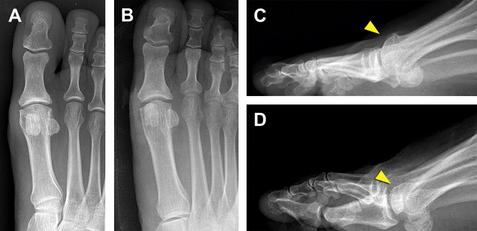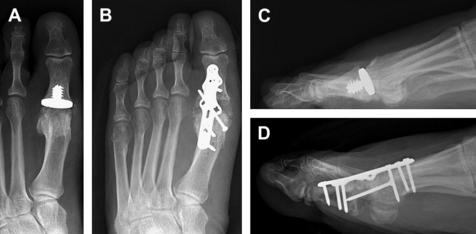End-Stage Hallux Rigidus
Cheilectomy, Implant, or Arthrodesis?
Keywords
• Hallux rigidus • Hallux limitus • Arthrodesis • Cheilectomy • First metatarsophalangeal joint
End-stage arthritis of the first metatarsophalangeal joint (MTPJ) typically results in an exophytic process with marked limitation of motion. Pain may occur from the degenerative process itself and/or the bone spur formation that may become directly inflamed from shoe gear. The best surgical treatment for end-stage arthrosis of the big toe joint continues to be a controversial topic despite hallux rigidus being recognized clinically for more than 100 years. Although joint-sparing procedures are considered, joint destructive procedures are recommended, as they are definitive and produce predictable results.
History of hallux rigidus
Hallux rigidus refers to the limitation of motion at the first MTPJ with particular limitation of hallux dorsiflexion. In 1887, Davies-Colley1 observed this limitation of motion, calling it hallux flexus, because of the relative plantar flexed position of the proximal phalanx in relation to the metatarsal head. Later that same year, Cotterill2 coined the term hallux rigidus, still the most commonly used expression for the condition. In 1937, Hiss3 described the same condition and developed the phrase hallux limitus. Although some surgeons consider hallux rigidus and limitus as distinct entities, others consider hallux limitus as an earlier stage of degenerative joint disease, in a continuum of joint degradation.
Etiology
The cause of hallux rigidus has not been determined, although multiple predisposing factors have been revealed. Hallux rigidus has been described in 2 different populations: a congenital form and an adult-acquired degenerative form. The congenital form usually presents in the teenage years through the 20s, from a predisposing anatomic factor, such as flattening or squaring of the metatarsal.4 The adult degenerative form typically presents in a relatively older population in their 40s and 50s, usually as a result of predisposing high-impact activities such as running or dancing. The adult form may be a continuation of the congenital form, although in most cases the exact cause is unknown. The incidence of hallux rigidus in men at age 50 is 31.7% and 40.9% in women of the same age. By age 65, those percentages increase to 51.0% and 67.8%, respectively.5 Forty-three is shown to be the average age at onset, and the average age at time of surgery is 50 years.6
Classification
Numerous investigators have proposed grading systems determined by radiographic changes only, or a combination of clinical and radiographic criteria. Although there are more than 7 classifications used to describe the progressive level of joint arthrosis, none have effectively offered prognostic value, but do offer useful treatment guidelines. The most common clinically used classification system is the Regnauld classification system (Box 1).
Box 1 Regnauld classification
Data from Regnauld B. Disorders of the great toe. In: Elson R, editor. The foot: pathology, etiology, seminology, clinical investigation and treatment. New York: Springer-Verlag; 1986. p. 269–81.
Surgical treatment
Surgery involving the first MTPJ has been present for more than 100 years. Arthrodesis was initially described in 1852 by Broca, but was not popularized for use as treatment for hallux rigidus until 1952 by McKeever.7 DuVries described the modified cheilectomy,8 which has remained a popular initial surgical treatment for hallux rigidus. It was not until the 1970s that Swanson popularized the silicone implant.
Cheilectomy
Since the original description of hallux rigidus in 1887 by Davies-Colley,1 variations have existed in the surgical methods of decompressing the MTPJ. It was not until 1959 that DuVries8 gave a detailed description of the cheilectomy that with modifications is still used by surgeons today. The cheilectomy has become a popular procedure for the treatment of early stages of hallux rigidus in which the major pathology is located at the dorsal aspect of the joint. The procedure is described as the resection of the dorsal 20% to 30% of the metatarsal head.6,9,10 Joint decompression offers relief of pain while preserving some motion, power, and stability. It also avoids prolonged healing time and it is easily revised, if necessary (Fig. 1).11–13
The decision as to whether cheilectomy is the appropriate surgical treatment for a specific patient who has hallux rigidus depends on a number of variables. The patient’s age, activity level, expectations, and prior treatment history are important, but are not considered as important as the severity of degenerative arthritis. Most of the reports on the surgical outcome of cheilectomy consider hallux rigidus grade as the leading differentiator for recommendation and indication for surgery. Some investigators recommend cheilectomy as a treatment of lower grades only,6,14–17 whereas others reported successful results even for higher grades of hallux rigidus.11,12,18 Blitz14 suggests that cheilectomy is indeed an option for end-stage arthrosis because the dorsal osteophyte is responsible for most pain, and removing this allows for enough pain reduction to satisfy patients’ expectations. Nonetheless, cheilectomy is clearly indicated for early stages, grades I and II, using the Regnauld classification scheme.19,20 Coughlin and Shurnas, however, do not recommend cheilectomy for stages III and IV of their 5-grade classification scheme.6
A primary issue associated with cheilectomy is the recurrence of chondrolysis and exostosis as well as further joint deterioration. Easley and colleagues18 performed 75 cheilectomies using the Hattrup and Johnson classification and American Orthopaedic Foot and Ankle Society (AOFAS) scoring system to evaluate results. The number of patients with grade III increased from 12 to 40 at the 2-year follow-up. Thirty-eight patients worsened at least 1 grade. They also found that the higher the grade at the time of surgery, the less predictable the AOFAS scores became. Patients undergoing cheilectomy should be counseled that given the progressive nature of osteoarthritis, future revisional surgery may be required.
Rates of satisfaction after cheilectomy have been favorable, ranging from 72% and 90%.11,12,18 Cheilectomy is still a “no bridges burned” type of approach to early-stage hallux rigidus. If the results of cheilectomy prove unsatisfactory, salvage with arthrodesis or resection arthroplasty can be performed in the future.
Arthroplasty
Implant arthroplasty is an alternative surgical option from the standard joint-sparing procedure of a cheilectomy and the joint-destructive procedure of an arthrodesis. The initial attempts and failures at first MTPJ replacement were in the 1950s and did not become widely used until 1965 when Swanson adapted a silicone-stemmed implant. The silicone cap functioned as a spacer following a Keller procedure; this allowed for soft tissue stabilization. In the 1980s, Sutter introduced 2 hinged silastic double-stemmed implants to the market. Sutter’s Lawrence and LaPorta gained motion for the mechanical hinge design, whereas the previous Swanson implants gained motion from the viscoelastic properties of the material. These implants temporarily relieved pain, but were not durable. There was mechanical failure of this implant and functionally decreased range of motion. Granberry and colleagues21 found the frequency of failure to be directly related to the age of the implant. Silicone implants have been associated with many complications, including late failure owing to wear, osteolysis, reactive synovitis, foreign body immune response, and fracture and displacement of components.22
Because of the limitations of silicone implants, metallic hemiarthroplasty (unipolar) and metallic total joint arthroplasty (bipolar) prostheses have been developed. Various implants composed of different materials have been manufactured to replace the base of the proximal phalanx, head of the first metatarsal, or both surfaces. Although long-term results of metallic implant hemiarthroplasty have been promising,23 some investigators continue to consider prosthetic replacement of the first MTPJ as investigational.24,25
Some metallic hemiarthroplasty (unipolar) design options for replacement of the base of the proximal phalanx include the Biopro (Biopro Inc, Port Huron, MI), Wright LPT (Wright Medical technology Inc, Arlington, TN), and Futura (Nexa Orthopedics Inc, San Diego CA) (Fig. 2).
Stay updated, free articles. Join our Telegram channel

Full access? Get Clinical Tree










